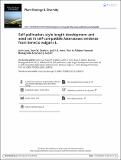Self-pollination, style length development and seed set in self-compatible Asteraceae: evidence from Senecio vulgaris L.
Abstract
Background: Variation in style length has been reported in Senecio vulgaris and has been associated with outcrossing rate. Aims: To determine if (i) long styles lack germinated pollen on stigmas left to self-pollinate, (ii) successful self-pollination causes styles to stop elongating and shrink in length and (iii) seed set increases with the amount of pollen deposited on stigmas. Methods: Determined germinated self-pollen on stigmas of long and short styles after auto-self-pollination; scored style length over 48 h in self-pollinated and non-pollinated florets; recorded seed set after placing different amounts of pollen on stigmas. Results: Most long-styled florets had zero or low amounts of germinated pollen on stigmas in contrast to most short-styled florets. Styles initially elongated to the same length in self-pollinated and non-pollinated florets, then shrank in length in self-pollinated florets while continuing to elongate in non-pollinated florets. Seed set increased with number of pollen grains deposited on stigmas. Conclusions: Successful self-pollen deposition and/or germination on stigmas of S. vulgaris are indicated by presence of short styles, whereas the opposite is indicated by presence of long styles in florets left to self-pollinate. Self-pollination causes styles to shrink after initially elongating. Seed set is dependent on the amount of pollen deposited on stigmas.
Citation
Love , J , Graham , S , Irwin , J , Ashton , P , Bretagnolle , F & Abbott , R J 2016 , ' Self-pollination, style length development and seed set in self-compatible Asteraceae: evidence from Senecio vulgaris L. ' , Plant Ecology & Diversity , vol. 9 , no. 4 , pp. 371-379 . https://doi.org/10.1080/17550874.2016.1244576
Publication
Plant Ecology & Diversity
Status
Peer reviewed
ISSN
1755-0874Type
Journal article
Description
The work was supported in part by the Natural Environment Research Council under Grants [(GR3/6203A; GR9/1782A] to RJA.Collections
Items in the St Andrews Research Repository are protected by copyright, with all rights reserved, unless otherwise indicated.

